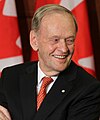21st G7 summit
| 21st G7 summit | |
|---|---|
 21st G7 summit official logo | |
| Host country | Canada |
| Dates | June 15–17, 1995 |
| Follows | 20th G7 summit |
| Precedes | 22nd G7 summit |
The 21st G7 summit was held on June 15–17, 1995 in Halifax, Nova Scotia, Canada. The venue for this summit meeting was Summit Place in Halifax.[1] It was labelled by Prime Minister Jean Chrétien as a "Chevrolet Summit", using a utilitarian automobile as a metaphor for the summit being less expensive than previous summits in Versailles and Venice.[2]
The Group of Seven (G7) is an unofficial forum which brought together the heads of the richest industrialized countries: France, Germany, Italy, Japan, the United Kingdom, the United States, Canada (since 1976)[3] and the President of the European Commission (starting officially in 1981).[4] The summits were not meant to be linked formally with wider international institutions; and in fact, a mild rebellion against the stiff formality of other international meetings was a part of the genesis of cooperation between France's President Giscard d'Estaing and West Germany's Chancellor Helmut Schmidt as they conceived the first Group of Six (G6) summit in 1975.[5]
Leaders at the summit[]
The G7 is an unofficial annual forum for the leaders of Canada, the European Commission, France, Germany, Italy, Japan, the United Kingdom and the United States.[4] Boris Yeltsin was also in attendance representing the Russian Federation.
The 21st G7 summit was the first summit for French President Jacques Chirac and the last summit for Japanese Prime Minister Tomiichi Murayama. It was also the first and only summit for Italian Prime Minister Lamberto Dini.
Participants[]

These summit participants are the current "core members" of the international forum:[6][1][7]
| Core G7 members Host state and leader are shown in bold text. | |||
| Member | Represented by | Title | |
|---|---|---|---|
| Canada | Jean Chrétien | Prime Minister | |
| France | Jacques Chirac | President | |
| Germany | Helmut Kohl | Chancellor | |
| Italy | Lamberto Dini | Prime Minister | |
| Japan | Tomiichi Murayama | Prime Minister | |
| United Kingdom | John Major | Prime Minister | |
| United States | Bill Clinton | President | |
| European Union | Jacques Santer | Commission President | |
| Jacques Chirac | Council President | ||
Issues[]
The summit was intended as a venue for resolving differences among its members. As a practical matter, the summit was also conceived as an opportunity for its members to give each other mutual encouragement in the face of difficult economic decisions.[5] Issues which were discussed at this summit included:
- Growth and Employment
- Meeting the Challenges of the 21st Century
- Strengthening the Global Economy
- Promoting Sustainable Development
- Reducing Poverty
- Safeguarding the Environment
- Preventing and Responding to Crises
- Reinforcing Coherence, Effectiveness and Efficiency of Institutions
- Creating Opportunities through Open Markets
- Economies in Transition
- Nuclear Safety
Accomplishments[]
This was the first year that the G8 summit was marked by an official World Wide Web site on the Internet sponsored by the Canadian Government. Two unofficial Web pages were also created, one set up by Dalhousie University in Halifax, the summit site, and the other created by teachers and students of Cornwallis Junior High School there.[8]
Gallery[]

 Germany
Germany
Helmut Kohl, Chancellor
See also[]
- G8
Notes[]
- ^ Jump up to: a b Japan, Ministry of Foreign Affairs (MOFA): Summit Meetings in the Past.
- ^ LA Times: U.S., Japan Still on Collision Course Over Trade : Diplomacy: Clinton and Murayama meet at summit, but neither budges on sanction threat
- ^ Saunders, Doug. "Weight of the world too heavy for G8 shoulders," Globe and Mail (Toronto). July 5, 2008; the G7 evolves into the G8 with the addition of Russia starting in 1997.
- ^ Jump up to: a b Reuters: "Factbox: The Group of Eight: what is it?", July 3, 2008.
- ^ Jump up to: a b Reinalda, Bob and Bertjan Verbeek. (1998). Autonomous Policy Making by International Organizations, p. 205.
- ^ Rieffel, Lex. "Regional Voices in Global Governance: Looking to 2010 (Part IV)," Archived June 3, 2010, at the Wayback Machine Brookings. March 27, 2009; "core" members (Muskoka 2010 G-8, official site). Archived June 2, 2010, at the Wayback Machine
- ^ MOFA: Summit (21); European Union: "EU and the G8" Archived February 26, 2007, at the Wayback Machine
- ^ Sanger, David. "International Business; A Glum Unity: The Group of 7 Sees Downhill," New York Times. June 15, 1995.
References[]
- Bayne, Nicholas and Robert D. Putnam. (2000). Hanging in There: The G7 and G8 Summit in Maturity and Renewal. Aldershot, Hampshire, England: Ashgate Publishing. ISBN 978-0-7546-1185-1; OCLC 43186692
- Reinalda, Bob and Bertjan Verbeek. (1998). Autonomous Policy Making by International Organizations. London: Routledge. ISBN 978-0-415-16486-3; ISBN 978-0-203-45085-7; OCLC 39013643
External links[]
| Wikimedia Commons has media related to 21st G7 summit. |
- Official G8 website: Halifax summit, 1995; n.b., no official website is created for any G7 summit prior to 1995.
- University of Toronto: G8 Research Group, G8 Information Centre
- G7 summits
- 1995 in Canada
- Diplomatic conferences in Canada
- 20th-century diplomatic conferences
- 1995 conferences
- History of Halifax, Nova Scotia
- 1995 in international relations
- June 1995 events in Canada







